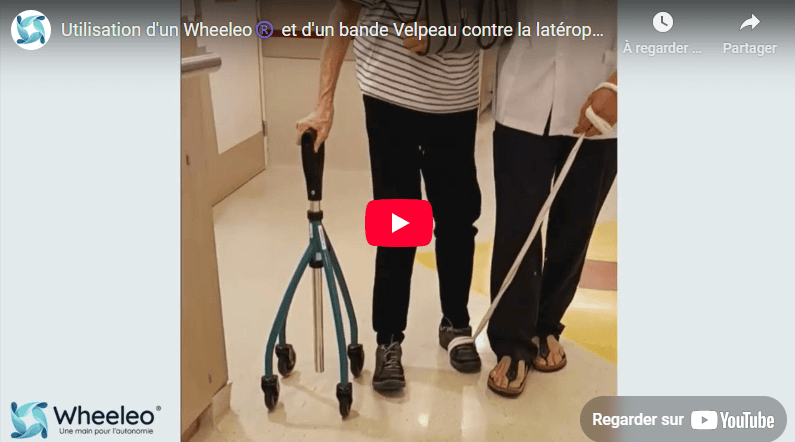
Following the use of a gait training ramp (beginning of rehabilitation), I selected the one-handed walker Wheeleo® as the first mobility device for this hemiplegic patient.
This choice was necessary due to a complex motor profile. The patient presents several gait alterations:
To compensate for lateropulsion, I adjusted the Wheeleo® to a low position. This strategy aims to promote the body’s natural inclination towards the handle, which counterbalances the inclination induced by the pathology. In other words, a controlled inclination towards support can correct a pathological inclination: minus by minus equals plus.
To limit falling towards the paretic side, I positioned a Velpeau® bandage to counter leg adduction. By placing the foot more outward, we optimize support and prevent adduction from amplifying lateral imbalance. This phenomenon is common in patients with gluteal muscle weakness.
The Velpeau® bandage also helps me during step-taking:
The patient wears a BlueRocker® orthosis. A small heel wedge could reduce hyperextension, but in this specific case, the hyperextension provides stable knee locking, ensuring some security during the stance phase. As often, this is a compromise between stability and physiology, to be evaluated on a case-by-case basis.
The Wheeleo® allows for a two-step gait, which represents a significant progress compared to the three-step gait often observed during ramp exercises or with aids like tripod canes or quadripod canes. The latter sometimes reinforce a degraded gait pattern.
On the other hand:
In the context of this complex rehabilitation, the Wheeleo® has proven to be a central tool. It not only allows addressing the patient’s specific deficiencies but also stimulates a more fluid, natural, and secure gait.
Every adjustment counts, and this type of device should be part of the modern rehabilitator’s toolkit.
It’s about finding the right moment to introduce the Wheeleo®: the lateropulsion must be sufficiently “manageable”. If using the Wheeleo® doesn’t work, it’s rare that a quadripod cane would do better. In this case, it’s better to return to working on a ramp, against a wall, with a visual reference on the ground to guide foot positioning.
Please fill in this short form so that we can contact you to arrange a test.